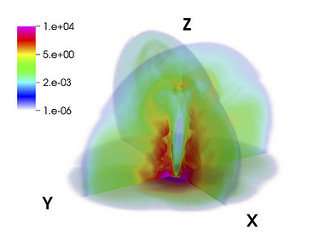Gamma-ray burst detection just what OSU researchers exclusively predicted

More than a month before a game-changing detection of a short gamma-ray burst - a finding announced today - scientists at Oregon State University predicted such a discovery would occur.
Scientists from U.S. and European collaborations converged on the National Press Club in Washington, D.C., today to say they've detected an X-ray/gamma-ray flash that coincided with a burst of gravitational waves, followed by visible light from a new cosmic explosion called a kilonova.
Gravitational waves were first detected in September 2015, and that too was a red-letter event in physics and astronomy; it confirmed one of the main predictions of Albert Einstein's 1915 general theory of relativity and earned a Nobel prize for the scientists who discovered them.
"A simultaneous detection of gamma rays and gravitational waves from the same place in the sky is a major milestone in our understanding of the universe," said Davide Lazzati, a theoretical astrophysicist in the OSU College of Science. "The gamma rays allow for a precise localization of where the gravitational waves are coming from, and the combined information from gravitational and electromagnetic radiation allows scientists to probe the binary neutron star system that's responsible in unprecedented ways. We can tell things like which galaxy the waves come from, if there are other stars nearby, and whether or not the gravitational waves are followed by visible radiation after a few hours or days."
Collaborators from the Laser Interferometer Gravitational-Wave Observatory, known as LIGO, and the European Gravitational Observatory's Virgo team on Aug. 17, 2017, detected gravitational waves - ripples in the fabric of space-time - produced by the coalescence of two neutron stars.
Roughly two seconds later, NASA's Fermi Gamma-ray Space Telescope detected a short flash of X- and gamma rays from the same location in the sky.
"The Fermi transient is more than 1,000 times weaker than a 'normal' short gamma-ray burst and has the characteristics that we predicted," Lazzati said. "No other prediction of such flashes had been made. Just by pen and paper almost, we could say hey, we might see the bursts, even if they're not in a configuration that makes them obvious."
On July 6, Lazzati's team of theorists had published a paper predicting that, contrary to earlier estimates by the astrophysics community, short gamma-ray bursts associated with the gravitational emission of binary neutron star coalescence could be detected - whether or not the gamma-ray burst was pointing at Earth.
The paper appeared in the journal Monthly Notices of the Royal Astronomical Society.
"X- and gamma rays are collimated, like the light of a lighthouse, and can be easily detected only if the beam points toward Earth," Lazzati said. "Gravitational waves, on the other hand, are almost isotropic and can always be detected. We argued that the interaction of the short gamma-ray burst jet with its surroundings creates a secondary source of emission called the cocoon. The cocoon is much weaker than the main beam and is undetectable if the main beam points toward our instruments. However, it could be detected for nearby bursts whose beam points away from us."
Since the first gravitational wave discovery, there have been three more confirmed detections, including the one from August that was jointly seen by scientists from the LIGO and Virgo groups.
"All observations until the last one were from the coalescence of binary black hole systems," Lazzati said. "While these systems are interesting, they are dark in any other form of radiation and relatively little can be understood from them compared to binary neutron star systems.
"It's a really lucky set of circumstances for a theorist, where you have a working theory to use to make predictions and new instruments such as LIGO and Virgo coming online to test them," Lazzati said. "Scientists don't make predictions because we want to be right - we make predictions because we want to test them. Even if we're wrong, we're still learning something - but it's much more exciting to be right."
The term neutron star refers to the gravitationally collapsed core of a large star; neutron stars are the smallest, densest stars known. According to NASA, neutron stars' matter is packed so tightly that a sugar-cube-sized amount of it weighs in excess of a billion tons.
More information: Davide Lazzati et al. Off-axis emission of short γ-ray bursts and the detectability of electromagnetic counterparts of gravitational-wave-detected binary mergers, Monthly Notices of the Royal Astronomical Society (2017). DOI: 10.1093/mnras/stx1683
Journal information: Monthly Notices of the Royal Astronomical Society
Provided by Oregon State University



















